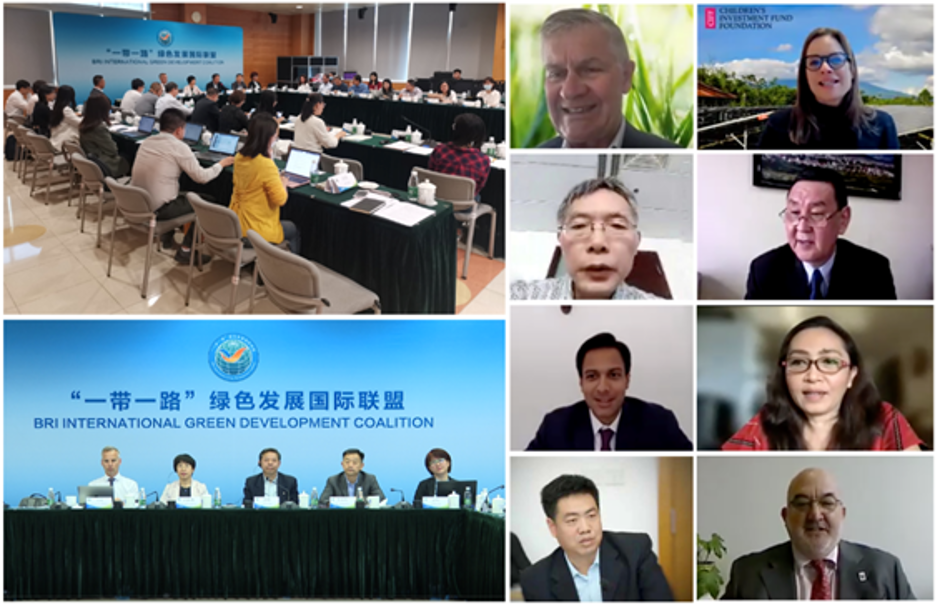On 17 May 2021, a Roundtable on the Green Development Guidance for BRI Projects was held by BRI International Green Development Coalition (BRIGC), World Resources Institute (WRI) and ClientEarth in Beijing. Chinese and international speakers joined the conference both online and on site.

Background
The BRI International Green Development Coalition (BRIGC) released the Green Development Guidance for BRI Projects (GDG) Phase I baseline study in December 2020. The baseline provides nine recommendations for greening the BRI and a classification system – the traffic light system – evaluating climate, pollution and biodiversity impacts of investments.
Within the traffic light system, projects are graded in “red” – environmentally harmful, “yellow” – environmentally neutral, and “green” – environmentally beneficial.
To accelerate the application and further development of the GDG, the BRIGC launched the GDG phase II research. The second phase aims to specify application guidelines for financial institutions and developers, and formulate green safeguards and development specification for sectors that can be upgraded from “red” to “yellow” or green, such as transportation infrastructure (railways and highways).
The BRI Green Development Guidance Roundtable
The roundtable had 3 sessions:
- Session 1: National Practices of Green Finance in the Context of Global Carbon Neutrality: Policies and Standards;
- Session 2: Climate Investment and Finance: Opportunities, Challenges and Actions for Financial Institutions;
- Session 3: Green Solutions for BRI Transportation Infrastructure.
The roundtable began with welcome and opening remarks by Mr. Li Yonghong, Deputy Director General, Foreign Environmental Cooperation Center (FECO), MEE; Mr. Erik Solheim, Convener of the BRIGC Advisory Committee, Senior Advisor of World Resources Institute (WRI); Mr. Guo Jing, Director General, Department of International Cooperation, MEE; and Ms. Kate Hampton, Convener of the BRIGC Advisory Committee, Chief Executive Officer of Children’s Investment Fund Foundation (CIFF). In the first session, speakers from several developing countries were invited to talk about their own country’s green finance status and development. They are, for example, Mr. Muhammad Irfan Tariq, Director General (Environment & Climate Change), Ministry of Climate Change, Pakistan; Ms. Nomindari Enkhtur, CEO, Mongolian Sustainable Finance Association, Mongolia; Mr. Mohd Munir, Chairman of ASEAN Business Advisory Council, Malaysia. They expressed their willingness and need to cooperate with China on green project development in their countries as part of Belt and Road Initiative (BRI). This session helps promote the policy communication among BRI participating countries around green finance, particularly the policies and standards that accelerate the investment and finance needed in the context of carbon peaking and neutrality, further promote the consensus and synergy to achieve green development of BRI.
In the second session, Mr. Christoph Nedopil, Director of the Green BRI Center, International Institute of Green Finance (IIGF), Central University of Finance and Economics (CUFE), as the first speaker, talked about the global climate finance status and development, challenges and solutions. He highlighted the importance of The Green Development Guidance Phase 2 as a solution for guiding climate finance in specific sectors such as transportation. Other speakers such as Zhao Zhongbu, Deputy Director, Business Appraisal Committee of Sinosure, complemented the topic of climate finance.
The third session focused on how to ensure transport investments in the BRI can become green and reduce environmental impacts. Ms. Lan Yan, Deputy Director, BRIGC Secretariat; Mr. Huang Quansheng, Deputy Director, Division of Environment and Resource Research, Transport Planning and Research Institute, Ministry of Transport; as well as speakers from China Communications Construction Company Limited and China Railway Construction Corporation Limited discussed the design and progress of the GDG phase II with in-depth involvement of financial institutions, enterprises among other stakeholders, and helped sharpen the focus and consolidate the work plan.
Summary and Outlook
The second phase of the GDG development is crucial for financial institutions, developers and partners involved in the BRI. It is clear that there is a strong interest in accelerating greening the BRI and more concrete and actionable guidelines should lead to a de-facto implementation of green finance in the BRI. One important aspect that has been stressed is international cooperation to accelerate knowledge sharing and co-financing. As an important institution of the BRI, the BRIGC and this roundtable shows that joint efforts to tackle climate change, protect biodiversity and improve livelihoods through investment and cooperation continue to play an important role.




Comments are closed.